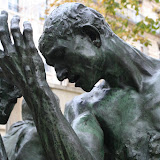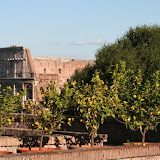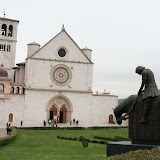People ask us all the time, what do you guys do with all your free time in Paris. My answer, we don't have that much...it all gets eaten up by French bureaucracy. Truthfully, we spent the month of November getting settled in our teaching jobs, showing my parents around our new home, and, yes, dealing with a lot of red tape.
For photos, click here.
 |
| Paris, Kim's Mom & Dad visit |
Kimberly
Just as soon as we arrived back from our Italian adventure, my parents came for their first visit. We were really excited to show them around our new neighborhood and take them to all our favorite places! We visited the Rodin and Orsay museums, spent an afternoon at Sacre Coeur in Montmartre, and watched the Eiffel Tower's sparkling performance at night from Trocadero square.
And one Wednesday, we even went to Disneyland Paris. Yes, I know, it seems silly to go to Disneyland over here, given that I grew up only an hour from the original. But, Daniel had never been...so this was an exciting day for him. (Really, he could have cared less...but I was excited to share the joy of Mickey and Minnie with him.) Actually, I thought it was really interesting to see what they changed for the French/European market. For example, they don't have the "Matterhorn" ride over here, Indiana Jones is a roller coaster, and Mr. Toad has a restaurant, not a ride.
The weirdest part? There were NO lines...I'm not kidding. I have NEVER seen anything like this at Disneyland. I have always had to wait for at least 45 minutes for a ride at Disneyland...and here we could just walk right onto almost all the rides Moreover, how they decided which rides to keep in English and which ones to have in French is beyond me. Given that a large majority of the park's visitors come from outside of France, I was surprised at the French language prevalence. But given that this is France, and the French are very very particular about the use of their language, I wasn't so surprised. I would love to have been a fly on the wall during the negotiations on this topic! All I know is that it was hard to fully enjoy Pirates of the Caribbean because I couldn't sing along...
On a completely opposite note, my parents took us to Taillevent, an exquisite three-Michelin-star restaurant in Paris, for a late birthday celebration, . For the price, it had better be amazing...but it was. All I have to say is "Foie Gras Creme Brulee"...I can't explain it, but it was incredible!
Teaching has been good, but very challenging. Some of my students are almost fluent in English, so I can have interesting discussions with them. These classes are great, and I feel like I am really helping them. But other classes are much harder...where most of the kids have such poor English that they don't understand anything that I say to them (except for the one smart kid who translates to the rest of them). And I've noticed something interesting...when the kids don't understand something, they just claim that they don't like it. I've been having them practice explaining images (cartoons, pictures, advertisements) because it's something they may have to do for their Baccalaureat Exam. I had several classes who all just didn't like this cartoon..then I showed it to a more advanced class, and they loved it. Hmmm....
And that leaves the last third of our time...spent dealing with French bureaucracy.
The following excerpt from "Paris to the Moon," a fabulous book by Adam Goepnick on his time living in the city, provides an interesting commentary on the French state of bureaucracy:
"Legend has it that among Frenchmen sex and food are supposed to take the place of sports, but in fact they don't. What the French do to bridge the uneasy competitive silences that seem to be the price of a Y chromosome is talk about government and particularly about the incompetence of government ministers; which minster has outdone the other in self-important pomposity is viewed as a competitive event....If talking about bureaucracy takes the place of talking about sports, getting involved with the bureaucracy takes the place of exercise. Every French man and woman is engaged in a constant entanglement with one ministry or another, and I have come to realize that these entanglements are what take the place of going to a gym where people actually work out. Three of four days a week you are given something to do that is time-consuming, takes you out of yourself, is mildly painful, forces you into close proximity with strangers, and ends, usually, with a surprising rush of exhiliration: "Hey, I did it!" Every French ministry is, like a Nautilus machine, thoughtfully designed to provide maximum possible resistance to your efforts, only to give way just at the moment of total mental failure. Parisians emerge from the government buildings on the Ile de la Cité feeling just the way New Yorkers do after a good workout: aching and exhausted, but on top of the world."
Mr. Goepnick is in no way exaggerating...yes, it really is that awful...it's that awful that you believe someone must have specifically designed the system to be this inefficient as some stupid solution to increase employment. (Really, I think so!)
And, as newly arrived foreigners here, we have lots of hoops to jump through. The problem is that they aren't so clear on where they are or how to jump through them. So, inevitably, you show up for your "rendez-vous" (appointment) with all the papers they tell you to bring, and they ask you for some other form, paper, or card that you likely have never heard of, obviously don't have with you, and likely have no idea how to procure. They make medical appointments for you to be screened by their doctors (keep in mind that we had to pass a medical exam when we applied for the program), but they don't notify you when the appointment is. When you call to try to find out, they tell you to "patienter" (which means wait...or be patient). So, you wait, and wait. A month later, you call back to inquire and they are upset with you that you missed your medical rendez-vous two weeks ago...the one that no one ever informed you of. No, not exaggerating a bit...
And then there is the added pleasure of being a recently married woman in France who has kept her maiden name. Apparently this concept is completely foreign to anyone working in French bureaucracy or banking. I don't actually plan to keep my maiden name permanently. I just was not able to change it before we left the States. So I have nothing against people calling me Kimberly Gehant or Madame Gehant. I do, however, have a problem with my bank account being in the name of Kimberly Gehant...because my passport, work-visa, and employment contract are all under the name of Kimberly Haimsohn. It took four visits to the bank, and the eventual changeover of our account manager, for them to change my name on the account. And that was only after I explained that the Academie of Versailles refused to pay Kimberly Gehant for Kimberly Haimsohn's work...so they had to change my name on the account. The really odd thing on this topic is that France is quite progressive in domestic matters like these, offering lots of domestic partnership benefits to couples (both hetero- and homo-sexual). So the banks and government offices are clearly set up to process a couple with two different last names...but apparently once you are married, you have to change your name.
All that aside, we are still loving living in France. Every time we take Zookie for a walk and pass Notre Dame or Pont Neuf or the Luxembourg Gardens, I have to pinch myself and say, "Yes, it really is true! I live in Paris!"
More restaurant recommendations:
Taillevent
http://www.taillevent.com/
15 rue Lamennais - 75008 Paris - 01 44 95 15 01
(For a three-star-Michelin dining experience, come here! Everything you would expect of such a meal. Perfectly polished service, exquisite cuisine, and an astronomical bill. Come for lunch if you can...same food, half the price.)
Le Reminet
http://www.lereminet.com/
3 rue des Grands-Degrés - 75005 Paris - 01 44 07 04 24
(A lovely little bistro just opposite Notre Dame, where Dan and I celebrated our six-month anniversary. The food was the best we have had in any Paris bistro. Just amazing! And the service was so warm and kind. They even brought out a little cake for us with a candle to celebrate our special day.)
Le Timbre
3 rue Ste-Beuve - 75006 Paris - 01 45 49 10 40
(One of the teachers at my school recommended this place, and it was spot-on! The chef is actually British, but seems to know quite well how to cook French cuisine. Slightly more upscale than Bistro basics, but still focused on simple dishes well prepared with fresh ingredients)



